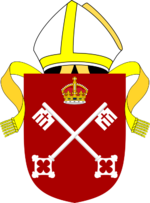Diocese of York facts for kids
Quick facts for kids Diocese of YorkDioecesis Eboracensis |
|
|---|---|

Coat of arms
|
|

Flag
|
|
| Location | |
| Ecclesiastical province | York |
| Archdeaconries | Cleveland, the East Riding, York |
| Statistics | |
| Parishes | 472 |
| Churches | 607 |
| Information | |
| Cathedral | York Minster |
| Language | English |
| Current leadership | |
| Bishop | Stephen Cottrell, Archbishop of York |
| Suffragans | Paul Ferguson, Bishop of Whitby John Thomson, Bishop of Selby Eleanor Sanderson, Bishop of Hull Stephen Race, Bishop of Beverley (AEO) |
| Archdeacons | Andy Broom, Archdeacon of the East Riding Sam Rushton, Archdeacon of York Amanda Bloor, Archdeacon of Cleveland |
| Website | |
| dioceseofyork.org.uk | |
The Diocese of York is a special area within the Church of England. It is part of a larger group called the Province of York. This diocese covers the city of York, the eastern part of North Yorkshire, and most of the East Riding of Yorkshire.
The main leader of the diocese is the Archbishop of York. Its most important church, or cathedral, is the famous York Minster. The diocese is split into three main areas called archdeaconries. These are Cleveland in the north, the East Riding, and York in the south-west. Each of these areas has its own special bishop.
This area used to be much, much bigger! It once included all of Yorkshire, Nottinghamshire, and Derbyshire. It also covered parts of Northumberland, Lancashire, Cumberland, and Westmorland.
Contents
Who Leads the Diocese of York?
The main leader of the Diocese of York is the Archbishop of York. He gets help from other bishops called suffragan bishops. These bishops help him look after different parts of the diocese.
The Bishops Who Help
There are three main suffragan bishops who support the Archbishop:
- The Bishop of Hull, whose role started in 1891.
- The Bishop of Whitby, whose role began in 1923.
- The Bishop of Selby, whose role started in 1939.
Each of these bishops usually looks after one of the three main archdeaconries. For example, the Bishop of Hull often helps with the East Riding area. The Bishop of Whitby helps with Cleveland, and the Bishop of Selby helps with York.
There is also a special bishop called the Bishop of Beverley. He helps parishes (local church areas) that have certain beliefs about women priests. He is known as a provincial episcopal visitor (PEV).
A Look at the History of the Diocese
The Diocese of York has changed a lot over hundreds of years. Its size and shape have been updated many times.
How the Diocese Shrunk Over Time
In 1541, a part of the diocese called the archdeaconry of Richmond, North Yorkshire became part of a new area called the Diocese of Chester. This part included areas like the Yorkshire Dales and parts of Lancashire and Westmorland.
Later, in 1572, an area called Hexhamshire was moved from the Diocese of York. It became part of Northumberland and the Diocese of Durham.
More changes happened in the 1800s and 1900s:
- In 1836, the western part of the diocese, which was mostly the West Riding of Yorkshire, was split off. It became the Diocese of Ripon and Leeds. This area later split even more and is now mostly the Anglican Diocese of Leeds.
- In 1884, Nottinghamshire and Derbyshire became part of the new Diocese of Southwell. Derbyshire then became its own diocese, the Diocese of Derby, in 1927.
- In 1914, the Diocese of Sheffield, which covers South Yorkshire, also became its own separate diocese.
These changes mean the Diocese of York is much smaller today than it was long ago.
How the Diocese is Organized
The Diocese of York is divided into three main areas called Archdeaconries. Each archdeaconry is then split into smaller local areas called Rural Deaneries. This helps to organize all the churches and parishes.
| Archdeaconry | Rural Deaneries |
|---|---|
| Archdeaconry of York | Deanery of New Ainsty
|
| Archdeaconry of Cleveland | Deanery of Guisborough
|
| Archdeaconry of the East Riding | Deanery of Beverley
|
For a long time, from 1972 to 2017, the Deanery of Hull was even more divided. It had three smaller areas: Central and North Hull, East Hull, and West Hull.
Images for kids


